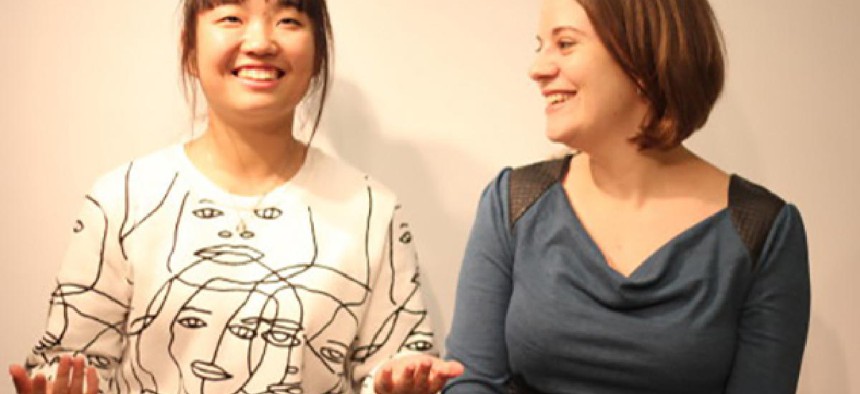Girls Write Now

A high school student, Corrine Civil, sat in a New York City cafe with her mentor Robin Marantz Henig, an author and New York Times Magazine contributor. The pair, brought together by Girls Write Now, a nonprofit that partners female writers with high school girls, worked on a writing prompt using a line lifted from a magazine as inspiration: “You finally had to sit down and have the talk.” Henig jotted about a character getting the sex talk for the first time, while Civil crafted her own short story. Once they finished writing, Henig read what Civil wrote and was initially confused. What did this have to do with sex?
“Even as I was reading her piece, I wasn’t watching it unfold in the right way,” said Henig, who is white. “It was a talk about how black kids should behave when cops stop them. It was that talk.”
Henig and Civil (who is black and Hispanic) often wrote in their one-on-one sessions about their views on race-related issues, like the riots in Ferguson, Missouri, with telling results. In addition to discussing writing, the pair also discussed college, family, boys and many other personal issues. “We’ve tried new writing genres together, watched each other transition into new stages of life, and I really appreciate her advice,” Civil said of her mentor. “Even though my time as a mentee has ended, she will always be my mentor.”
After spending three years in the Girls Write Now Program, Civil graduated from high school and starts classes at Columbia University this fall.
Over its 17-year history, Girls Write Now has served over 5,000 girls from all five boroughs with its writing and digital media mentoring programs. Ninety-four percent of program participants, referred to as mentees, are girls of color. Ninety-three percent are considered high-needs, and 100 percent of mentees go on to college, thanks in part to a college-bound curriculum incorporated into the mentoring programs. But at the core of Girls Write Now is the goal to develop the creativity of young women.
“Part of our mission is to give girls a voice,” said Maya Nussbaum, founder of Girls Write Now. “Part of that means putting pen to paper but also knowing how to present their work and share it.”
To work up to this, girls meet weekly in one-on-one sessions with their mentors and then in monthly writing workshops with other mentors and mentees.
Over the course of months, the pairs work on crafting pieces to present at the Girls Write Now CHAPTERS reading series, which features mentees – sometimes joined by their mentors – reading their work on stage. Girls in the digital mentoring program have opportunities to present and explain the process of their projects as well, which are also writing-driven.
The presentation aspect of the program holds great significance for the mentees. Though she was nervous, Civil cites her first reading series, where she read about her mother’s hospitalization following Superstorm Sandy, as an important developmental moment for her. “Writing about it, and being able to turn it into a sign of my resilience, was very cathartic for me,” she said. “It was a real breakthrough for me, in terms of my confidence in my writing and performing abilities.”
In addition to the reading series, Girls Write Now compiles the girls’ work into an anthology, which has been honored by the Indie Excellence Awards and the New York Book Festival, to name a few. The writing pieces in the anthologies reflect a yearly theme developed by Girls Write Now.
With over 80 percent of non-graduating mentees returning for a second year, it’s important to Nussbaum that the programs remain rigorous and stimulating. “In order to provide that environment, we are really using our curriculum model but (are) infusing it with new ideas,” she said. “We are actually trying to break down the somewhat artificial boundaries that exist between writing and digital media. We see them as all fundamental to what girls need to be successful in the 21st-century school and job market.”
Girls Write Now, in addition to being recognized twice by the White House for its work, regularly attracts well-known guest speakers for its reading series and monthly writing workshops. Last June’s CHAPTERS reading featured Pulitzer Prize winner Quiara Alegría Hudes, and in the past, speakers have included Roxane Gay, Emily St. John Mandel and Tiphanie Yanique.
Laura Maria Censabella spoke at a December writing workshop about her award-winning play "Truly Mary" and how she relates to the girls in the program. “When I was the age of most of the girls who participate in Girls Write Now, I didn't believe that I could write a play or screenplay because I didn't know any writers where I grew up in Queens, let alone female writers,” Censabella said.
It’s true that female writers are underrepresented to this day. Over the past five years, VIDA: Women in Literary Arts has compiled data on major publications that review books revealing that, generally, more book reviews are written by men about books also written by men. In 2014, women made up less than 40 percent of U.S. newsrooms, according to ASNE, which collects census data.
Henig, who has been with Girls Write Now for almost seven years and has had two mentees, doesn’t think either will end up being a professional writer, and knows many girls in the program won't. And to her, that’s OK.
“These are ethnically diverse writers, and they are writing about their experiences that aren’t typically white middle-class experiences,” she said, adding that by developing their writing skills, girls can have a larger positive impact on society. “Obviously, we need more literate, thoughtful, expressive people to tell us their view," Henig said. "Or else we won’t understand it.”
NEXT STORY: Front-line Hero: Natalie Cox
